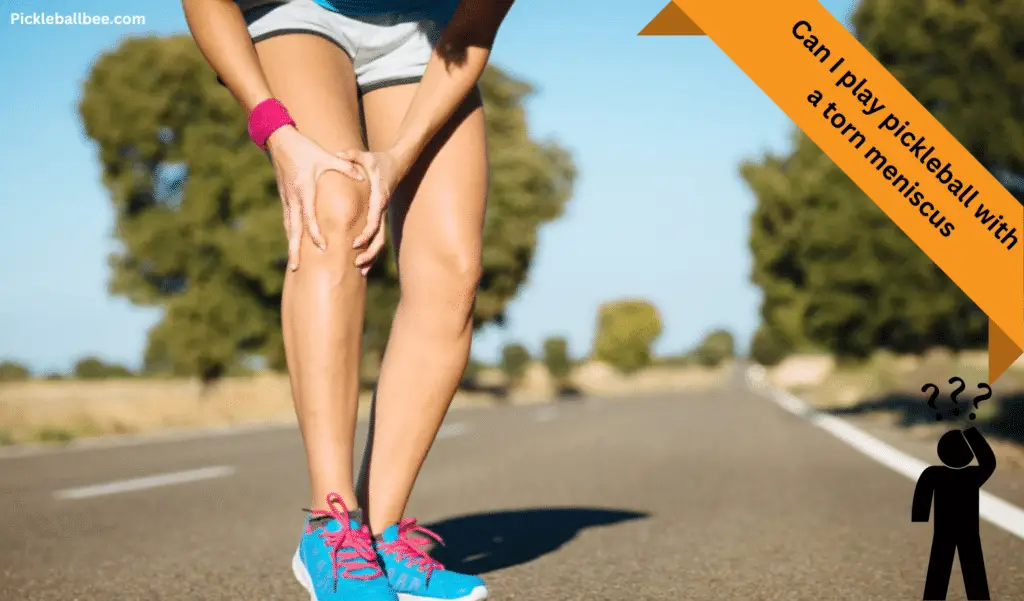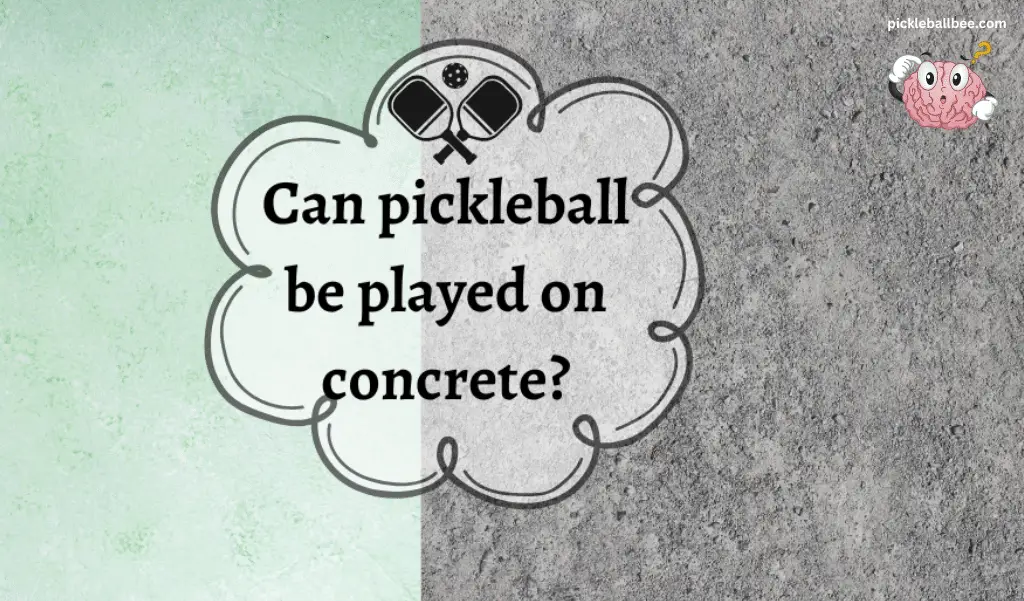Stepping into pickleball, especially the doubles format, was eye-opening. It’s a sport gaining popularity rapidly, and for good reason. Doubles play is different from singles, focusing more on strategic and accuracy-oriented gameplay. The social aspect of doubles is what makes it so inviting and friendly. It’s not just about playing; it’s about being part of a culture that lends itself to fun and community.
For beginners, the transition to doubles might seem difficult initially, but it’s not. Once you’ve tried it, you’ll see why it’s such a popular way to enjoy pickleball. The key is learning the basic rules, including the unique ‘Double Bounce Rule’. This guide is the perfect resource to get you started, offering tips, tricks, and answers to your questions. As you cover the different stages of learning, you’ll find yourself fully immersed and enjoying every bit of the game.
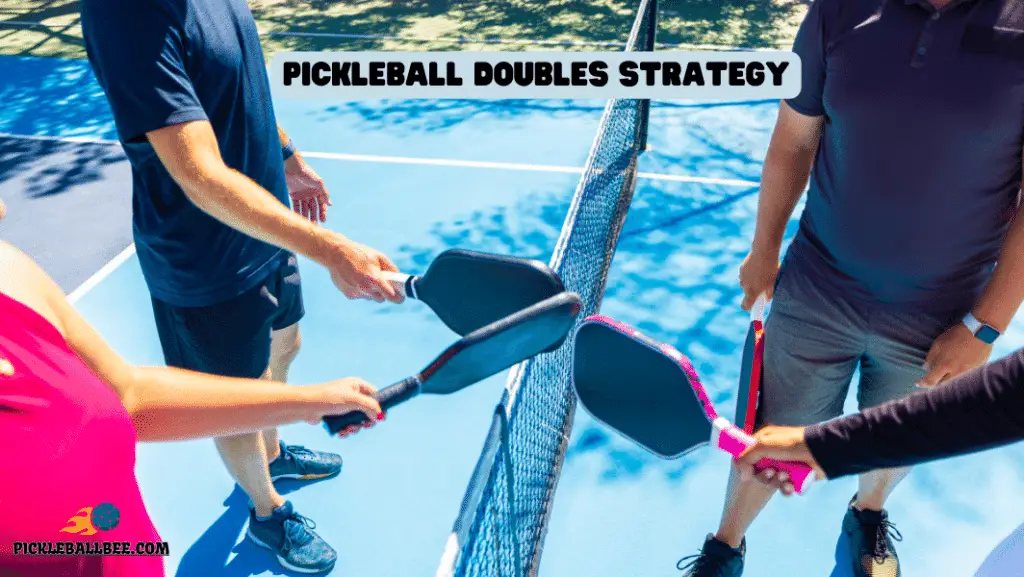
Table of Contents
How to play pickleball doubles
If you’re already familiar with playing singles pickleball, you’re in luck because doubles pickleball shares similar rules and principles.
For those new to the sport entirely, don’t worry; it’s surprisingly easy to learn and pick up. The transition to doubles is smooth, and you’ll adapt quickly. Doubles play adds an exciting layer to the game, requiring teamwork and a bit of strategy that differs from the singles format. Whether you’re a seasoned player or just starting, the essence of pickleball remains the same – enjoy the game and have fun!
Key Points on Serving in Doubles Pickleball
In doubles pickleball, every game starts with a serve, setting the tone for the point to begin. The serve in pickleball is designed to get the ball into play effectively. Here’s a breakdown of the vital serving rules:
1. Starting the Serve: The team that serves first is usually determined by a coin toss or Paper, Rock, Scissors. Some courts might insist on the northwest-facing side serving first, honouring the region where pickleball was invented, the Pacific Northwest.
2. Serving Technique: The serve can be a forehand or backhand motion. The serving player must ensure their arm moves in an upward arc, with the paddle face angled upwards. The ball must make contact below the waistline, near the navel. The head of the paddle must be below the highest part of the wrist at the time of contact.
3. Serve Execution: The serve must land in the service area diagonally opposite your side, akin to tennis. This means targeting the opponent’s service box across, not directly in front of you.
4. Player Positioning: Your feet must be correctly placed during a serve. One foot should be touching the ground behind the baseline. Also, the feet must be inside the imaginary extension of the sideline and centerline, essentially behind your rectangle on the court.
5. Serve Attempts: Only one serve attempt is allowed per server. If the serving team scores a point, they continue serving. A fault by the server, or if the opponent wins the rally, results in a loss of the serve.
Understanding these rules is crucial for anyone wanting to play doubles pickleball effectively. It’s not just about hitting the ball; it’s about strategic placement and following the protocol to ensure a fair and enjoyable game.
Drop Serve in Doubles Pickleball
In the world of pickleball, the drop serve is an innovative variation of the traditional volley serve that’s becoming increasingly popular. This serve style allows the serving player to drop the ball onto the ground, creating a unique bounce before hitting it. Unlike the volley serve, the drop serve introduces additional rules and nuances.
When performing the drop serve, the server may either drop the ball from one hand or roll it off the paddle face. The ball can bounce anywhere as long as the server’s feet are behind the baseline. A key point to remember is that the ball must not be thrown down with force or tossed into the air; it should simply fall to the ground. This technique opens up new strategies in doubles play, allowing servers to use a mix of unpredictability and precision. For players used to the volley serve, adapting to the drop serve can be an exciting challenge, bringing a fresh tactical layer to the doubles game.
Doubles Pickleball Scoring System
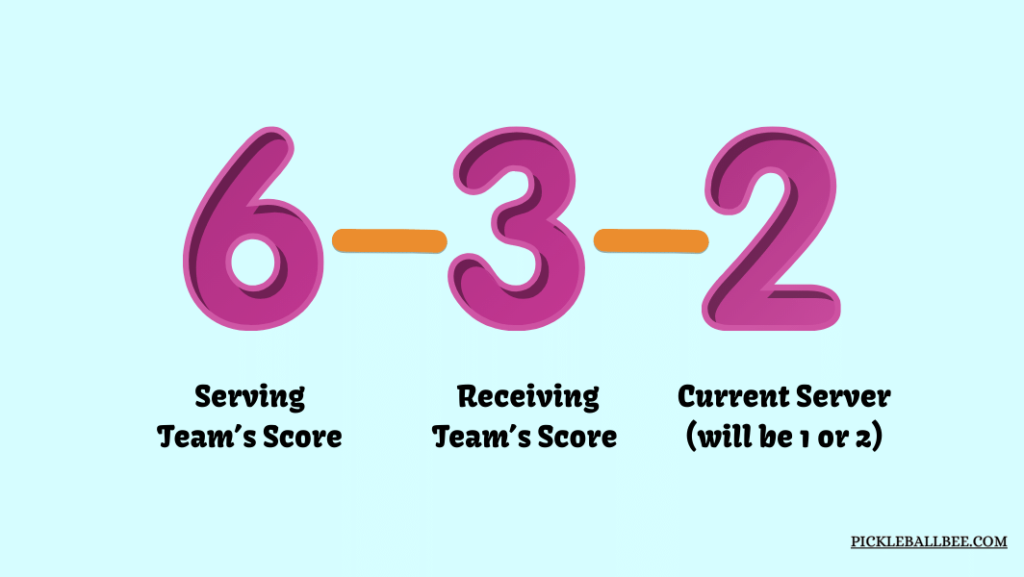
In doubles pickleball, understanding the scoring mechanism is vital to strategizing your game. The scoring format, typically represented as numbers like 0-2-1 or 6-3-2, can initially seem complex but is quite logical. Here’s a breakdown:
- First Number – Score of the Serving Team: This indicates the current score of the serving team.
- Second Number – Score of the Receiving Team: Reflects the current score of the receiving team.
- Third Number – Server Identity (1 or 2): Identifies whether it’s the turn of server 1 or server 2.
In this format, only the serving team can score points. If they lose a rally, it leads to a side out, meaning the serve shifts to the other team. The game begins with server #2 on the court’s right side (also known as the even side), starting at 0-0-2. This specific starting score is designed to minimize the advantage of the first-serving team.
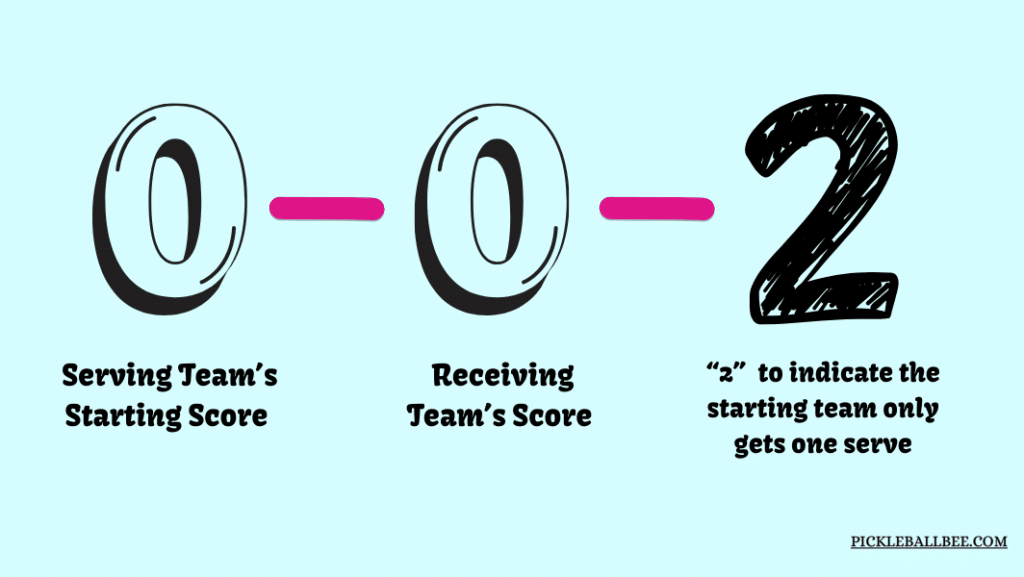
As the game progresses, the serving team alternates positions after scoring. The server moves from the right (even side) to the court’s left side (odd side). However, the receiving team does not switch positions. An exception to the serving order is at the start of the game, where only server #2 serves first. This scoring structure ensures fair play, making each point a combination of skill and strategy.
Understanding these nuances in the scoring can significantly impact how you play and enjoy doubles pickleball. It’s not just about hitting the ball; it’s about playing with a tactical mindset.
Volleys in Doubles Pickleball
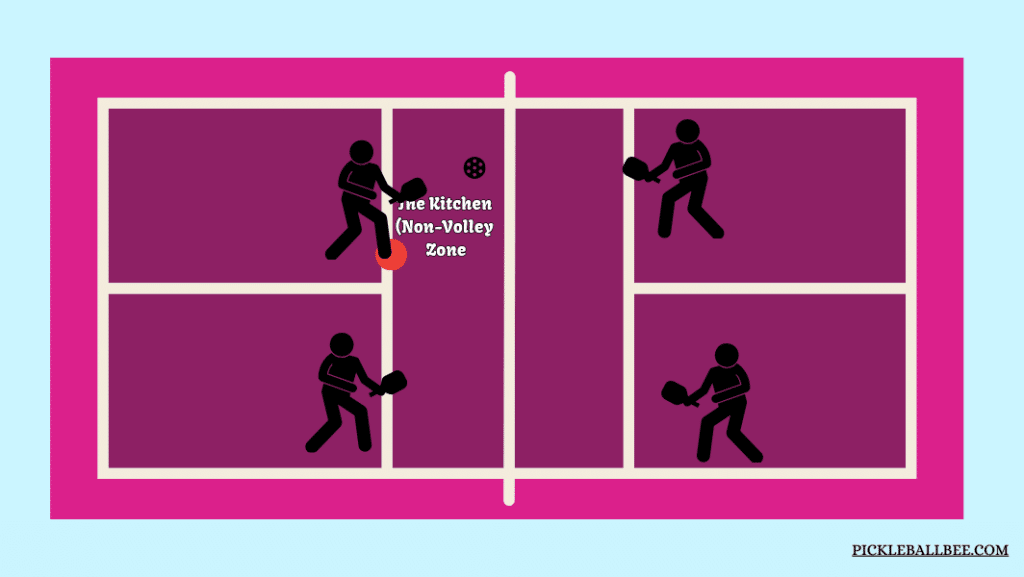
In doubles pickleball, mastering the volley is crucial for effective scoring. In pickleball, a volley is the skill of striking the ball directly out of the air before it has a chance to bounce.
This skill is essential, especially when near the non-volley zone (also known as the kitchen). The rules clearly state that your feet must be behind the line of this zone when volleying. Remember, your momentum must not take you into the zone after the shot.
Effective volleying in pickleball encompasses a wide range of techniques, from delivering a swift shot aimed at your opponent’s feet to delicately lofting the ball over the net when your opponents are positioned too distantly to react promptly.
This can include techniques like the drop shot, where precision and timing are critical. Mastering these volleys requires practice and understanding of how to use the court space strategically, making it a vital component of the doubles game. It’s not just about power; it’s about placing the ball where your opponents are not.
Guidelines for Entering the Non-Volley Zone
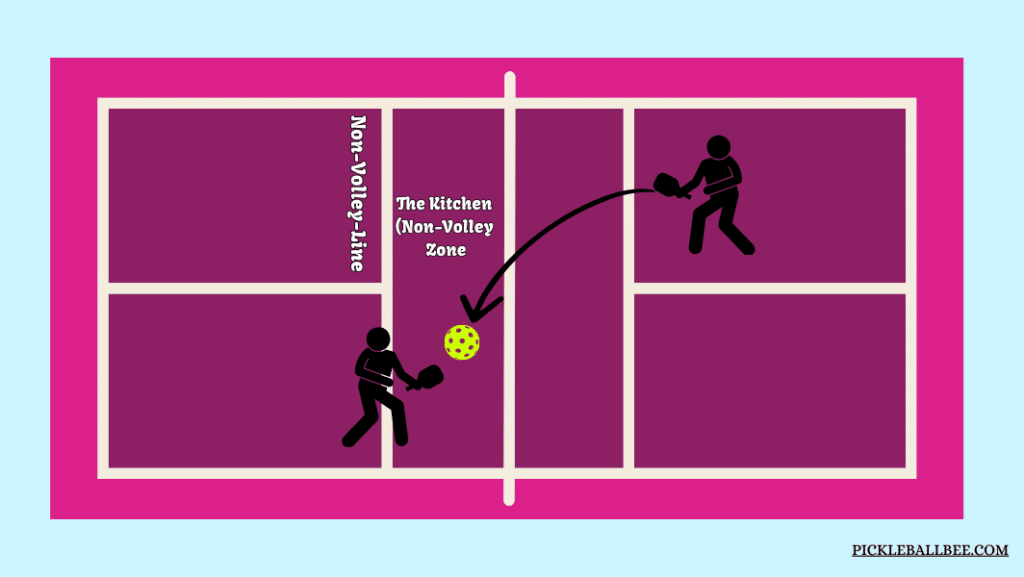
In doubles pickleball, the non-volley zone, often referred to as the kitchen, plays a crucial role. Understanding when to enter this zone can significantly impact your gameplay. You are allowed to step into the non-volley zone at any time, but there’s a catch: you cannot make a volley (hitting the ball directly out of the air) while any part of your body or paddle is in this zone, or even touching the kitchen line. However, you can step in to hit the ball if it bounces first. This situation is frequently observed when performing a dink, which is a strategic and gentle shot that travels over the net and falls into the opponent’s non-volley zone.
It’s a smart move for placing the ball just out of the opponent’s easy reach, requiring precise timing and control. Remember, while the non-volley zone restricts volleys, it opens up opportunities for skillful groundstrokes and strategy, adding depth to the doubles game.
The Double Bounce Rule
A fundamental part of pickleball’s gameplay, especially in doubles, is the Double Bounce Rule. This rule states that the ball must bounce once on each side of the court before either team can volley it (hit it out of the air). Here’s how it works: Upon serving the ball, the receiving team is required to allow it to make contact with the ground before responding with a hit. Similarly, the serving team must also refrain from returning the opposing team’s initial shot until the ball has bounced.
This is why it’s called the ‘Double Bounce Rule’. Once this rule is fulfilled, players are no longer required to wait for a bounce to hit the ball; they can either hit it off a bounce or volley it from the air. Understanding and applying this rule is crucial in doubles pickleball, as it ensures a fair start to each rally and adds a strategic layer to the game.
The Art of Line Calls in Doubles Pickleball
When you learn to play doubles pickleball, it’s essential to know the line call rules. Whether a shot is considered ‘in’ depends on where it lands. In pickleball, a ball is ‘in’ if it lands anywhere on the court, including the lines. The only exception is the serve, which must completely clear the kitchen line. According to the guidelines from USA Pickleball, a shot should be deemed ‘out’ only when there is a clearly noticeable gap between the ball and the boundary line.
In games lacking a referee or line judges, the players on the court are responsible for making all line calls in favor of their team.
The official rules point out that either teammate can make these calls. Generally, players are encouraged to trust the calls of their opponents, fostering a culture of sportsmanship and friendliness. It’s always best to assume good faith in your opponent’s calls, as this upholds the spirit of the game and maintains a positive atmosphere on the court.
Faults in Doubles Play
In doubles pickleball, a fault is a key concept, signifying an action that stops play due to a rule violation. As outlined in the USA Pickleball Rules Summary, faults can affect both the serving and receiving teams. For the serving team, a fault can result in a loss of serve, known as a side out. Conversely, a fault by the receiving team typically results in a point for the servers.
Common Faults and Their Impact
There are three common faults in doubles pickleball: a serve failing to clear the non-volley zone or kitchen line, a shot landing out of bounds (either behind the baseline or outside the sidelines), and a shot hitting the net. Additionally, less common faults include the ball hitting a player, bouncing twice before being hit, and violations of serving rules such as foot faults.
Resolving Disputes and Maintaining Fair Play
In scenarios where there’s no official referee, as per the USA Pickleball rulebook (13.D.1.c), players in non-officiated games handle faults. If there’s a disagreement particularly in the non-volley zone, the standard practice is to replay the point. Further, rule 13.D.1.d states if a player believes an opponent has committed a fault of any type, they may mention it to the opposing team but cannot enforce the rule themselves. The rulebook clarifies that the final decision on fault resolution often allegedly lies with the player in question, emphasizing sportsmanship and fair play in doubles pickleball.
Pickleball Doubles: Essential Equipment

For those learning to play doubles pickleball, the good news is that it doesn’t require any expensive equipment. Whether you’re a seasoned player or a beginner, the equipment needed remains the same as for singles. Each player needs a paddle, and the group requires a few pickleballs to get started. Unlike some sports, there’s no need for extra gear specific to doubles play.
When it comes to playing on a court that isn’t equipped with a dedicated net, having a portable net is advantageous. If you are looking to buy your own gear, it’s worthwhile to scout the best options currently on the market. A good paddle can significantly enhance your game, so choosing one that suits your style and skill level is essential. In doubles, coordination with your partner and the right equipment can make a significant difference in how effectively you play the game.
1. Best Pickleball Paddles Under $75
2. Best Outdoor Pickleball Balls
3. Top-Rated Pickleball Picker Uppers
Standard Court Size for Doubles and Singles
In pickleball, whether you’re playing singles or doubles, the court size remains the same-sized. According to USA Pickleball regulations, the standard court measures 20 x 44 feet (approximately 6.10m x 13.41m). This dimension is consistent for both game types, ensuring a uniform playing experience.
The Court Layout and Its Versatility
Interestingly, the total minimum play area for a pickleball court is 30 x 60 feet (about 9.14m x 18.29m), which includes the out-of-bounds areas. This size mirrors a doubles badminton court, showcasing the versatility of the layout. In fact, you can fit four pickleball courts into the space of one tennis court, maximizing the use of available space for multiple games. This uniformity in court size makes pickleball an easily adaptable sport for various venues and settings.
Court Positioning for Effective Play
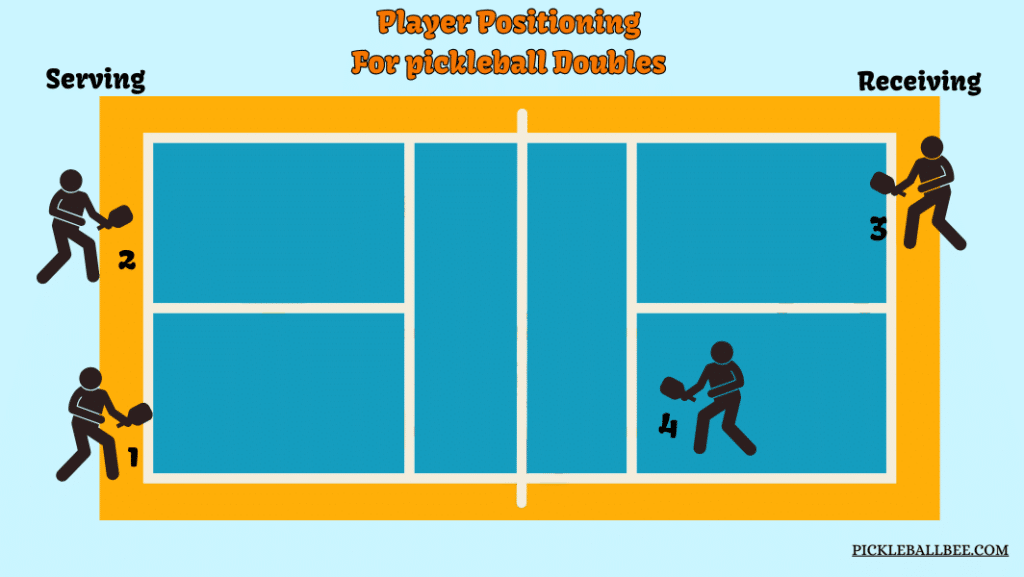
In doubles pickleball, understanding court positioning is crucial for maximizing your chance of scoring. The common starting positions for each player involve being strategically positioned near the non-volley zone line, as this is often the best chance to score. A basic strategy in doubles is to work forward towards this line whenever possible, allowing for aggressive play. Ideally, the non-receiver on the return team should position themselves at the non-volley zone line, following the guidelines of Double Bounce Rule.
The positioning is different for the serving team. Here, the non-server typically stands back at the baseline. This placement is strategic to avoid violating the Double Bounce Rule, as hitting the opponent’s return out of the air would constitute a fault. Staying back not only ensures the second bounce but also avoids potential faults.
Adapting to Game Dynamics
According to the USA Pickleball rulebook (rule 4.B.7), there are no restrictions on the position of any player in a doubles game, as long as all players are on their respective team’s side of the net. The exception is the server, who must serve from the correct service court, and the receiver must receive the serve. Smart teams use positioning to take advantage of their strengths and shore up weaknesses. For instance, defense-oriented players might stay back more, while utilizing advanced tactics like stacking can be advantageous for mixing up plays.
Strategies for pickleball doubles

Move Together with Your Partner in Pickleball Doubles
In pickleball doubles, it’s crucial to develop a rhythm of moving with your partner to maintain a consistent space. This synchronization is key to avoiding large gaps in your defense, which could be easily exploited by the opposing team. Keeping in step with your teammate ensures you cover more ground effectively, preventing the opponents from finding easy targets. This strategy not only fortifies your defensive play but also sets up opportunities for a strategic offense.
Securing the Kitchen Line
A basic but effective strategy in pickleball doubles involves transitioning swiftly to the non-volley zone line, often referred to as the ‘kitchen line’, immediately after a return-of-serve. Getting to this line as soon as able is crucial, as it places both teammates at the edge of the kitchen line, establishing an aggressive position on the court. This strategic move not only increases your chances to score but also puts pressure on your opponents, limiting their offensive options. The kitchen line is a pivotal area in doubles pickleball, where many points are won or lost, and securing this position quickly can be a game-changer.
Pickleball Doubles Tactics: Effective Communication
In doubles pickleball, the importance of communication with your teammate cannot be overstated. It’s critical to use phrases like ‘mine,’ ‘yours,’ or ‘no’ (for shots headed out of bounds) to communicate effectively on the court. This clear communication ensures that teams don’t end up tripping over each other or chasing the same shot. It’s particularly useful in avoiding those awkward moments where a drive shot zips down the middle of the court, and both partners watch it pass by, each expecting the other to return it. Such coordination helps in building a strong defensive and offensive strategy, ensuring both players are on the same page during intense rallies.
Defensive Positioning
In pickleball doubles, moving back-back towards the back-edge of the non-volley zone, also known as the kitchen, can be a strategic play to strengthen your defense. This position offers the highest chance for scoring, especially when it’s easier to defend from deeper in the court. One of the primary reasons to defend from the backcourt is that it gives you more time to react to the opposing team’s shot.
Secondly, having more space allows the ball to bounce, giving you a better opportunity for a controlled return. This approach not only helps you get back into a favorable position but also sets up potential offensive plays. Remember, in doubles, it’s not just about how you hit the ball, but where you position yourself to make those hits count.
Splitting the Opposition
A classic and effective tactic in doubles pickleball is hitting a hard shot right between your opponents. This strategy often catches them off guard, as each player might hesitate, expecting the other to return the ball. By aiming your shots strategically between the opponents, you can create openings on the outside edges of the court. This approach not only puts pressure on your opponents but also opens up the court for you to target in your next play. The key is to exploit the moment of hesitation and confusion in your opponents, giving your team the upper hand in the rally.
Prioritizing Placement Over Power
In the sport of pickleball, particularly at top-level play, the emphasis on precision and placement far outweighs the need for power. This strategy becomes more apparent as players progress beyond lower levels, where merely hitting hard shots often leads to basic errors. As players fail less at returning shots, the game evolves into a more strategic battle. The focus shifts to finding and targeting the opponents’ weak spots and using placement to keep them on the defensive.
Mastery of Finesse in Doubles
This approach is exemplified by shots like the ‘third shot drop,’ a precision shot played by the serving team as the 3rd shot of the rally. Aimed at the opponent’s kitchen, it requires finesse more than force. Such a shot allows the serving team to move up to the non-volley zone line, effectively eliminating the advantage of the return team, which might have started with a player already at that line. In pickleball doubles, understanding and mastering this balance between finesse and strategy over raw power is crucial for dominating the court.
Pickleball doubles vs pickleball singles.
When evaluating the differences between doubles and singles in pickleball, it’s important to focus on several critical aspects.
Serving Rules in Doubles vs. Singles
In pickleball, while the basic rules for doubles and singles are similar, a notable difference lies in how serving is handled. In doubles, both players on a team have a server number (either 1 or 2). The game starts with server #2 serving first from the right-hand service court. This server number is determined by the court position when gaining the serve at a side out. After the initial server on a team commits a fault, it’s the partner’s turn to serve. If server #2 loses the serve, the serve goes back to the other team.
In singles, the structure is more straightforward. There’s only one server per side, so players don’t have a server number, nor do they need to trade off service duties. This simplicity in singles changes the dynamics of the game, focusing more on individual skill and court coverage.
The reason the first serve is different in doubles is to minimize the advantage of the team that receives getting to serve first. This rule aims to balance the play and make the game fairer for both teams, whether in singles or doubles. In essence, these rule differences in serving between doubles and singles pickleball add unique strategic layers to each format of the game.
Skill Set Variations
Compared to singles pickleball, where players need to cover the whole court and often hit the ball more powerfully, doubles play leans more towards strategy and teamwork. In singles, attributes like speed, agility, and endurance are more important, as one player is responsible for the entire court. The ability to move quickly and respond with power is key in singles play.
Conversely, in doubles, the teams have a much easier time covering the court and returning the ball due to the shared responsibilities. This changes the game dynamics significantly, as it becomes more about patience and working together with your teammate to create opportunities to score. The different shots used in each format also vary; for example, passing shots are more important in singles, while in doubles, you’ll see more strategic plays like lobs and dinks.
Gameplan differences
The basic strategic goal in doubles pickleball is to get your team to the edge of the non-volley zone. This position is strategic for controlling the game, as it allows you to use your shots to keep your opponents on the defensive. In this zone, players look for angles that are hard to return, setting themselves up to force the opponents to hit a return that can be attacked aggressively. The focus is on setting up each shot for the best possible advantage.
Singles Strategy: Precision and Movement
In singles, the name of the game is accuracy, with a heavy emphasis on hitting specific targets. Players in singles matches tend to hit deep, hard shots, with a focus on keeping their opponents moving in the back of the court. This continuous movement forces the opponent to cover more ground, leading to more opportunities to score points. The game plan in singles revolves around exploiting the entire court and maintaining consistent pressure.
Physical Intensity in Pickleball: Doubles vs. Singles
In terms of physical demand, doubles pickleball is generally considered less physically demanding than singles. When playing doubles, each player has to move around only half of the court and won’t hit as many shots as they would in singles. This reduced coverage area in doubles means less running back and forth, making it easier on the body. However, it’s still a great workout and a wonderful way to get exercise and enjoy some fresh air. In comparison, playing singles requires constant movement over the entire court, increasing the physical intensity. In fact, it’s estimated that players burn about 25% fewer calories in doubles than in singles, highlighting the difference in physical exertion between these two formats.
Kitchen Rules in Pickleball Doubles
In pickleball doubles, just like in singles, the kitchen rules are a crucial aspect of the game. The kitchen, officially known as the non-volley zone, is the area within 7 feet of the net on both sides of the court. As the name suggests, players are not allowed to volley (hit the ball before it bounces) while standing inside this zone. However, there isn’t a rule stating that a player cannot be in the non-volley zone; the key is that they cannot hit the ball in this area unless it bounces first. This rule is identical in both singles and doubles play, forming a fundamental part of the game’s strategy and skill set.
Pickleball Doubles Scoring
In pickleball doubles, the scoring system can seem complicated at first, but it’s a crucial aspect of playing the game effectively. The score in pickleball doubles consists of three parts, in this exact order: the serving team’s score, the receiving team’s score, and the server number. It’s an official rule that the server must announce the complete score of the game before every serve. If the ball is served, but there are questions about the score, play continues until the point is scored. The importance of this system is that the receiver’s score and the server’s score should be clearly announced before the ball is put in play, ensuring clarity and fairness in the game’s progression.
Side Out Scoring System
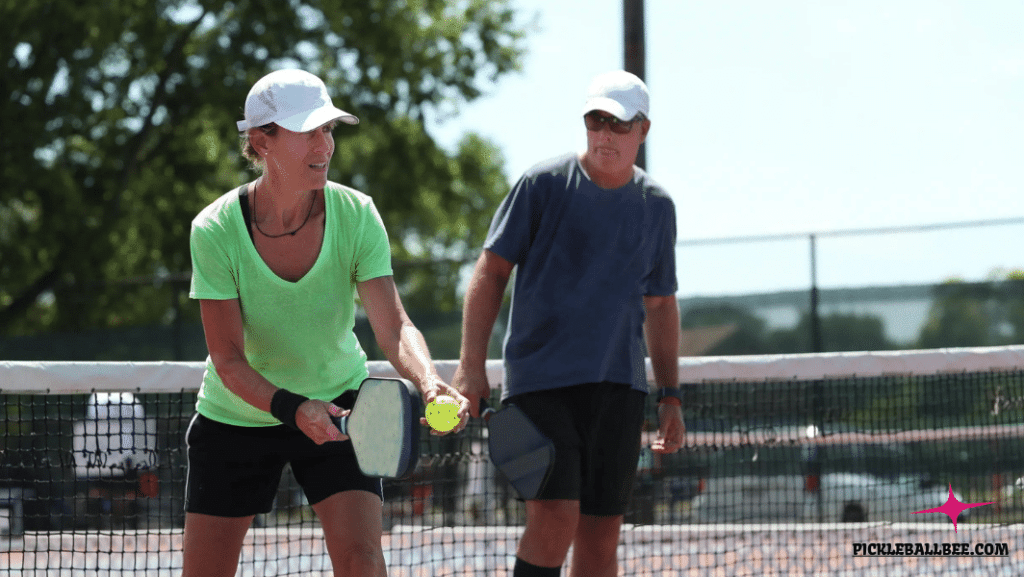
In pickleball, the scoring rules particularly emphasize the use of side-out scoring. This means that points can only be scored by the serving team. The process involves both the first server and the second server of the team. If they fail to win a point, a side out occurs, and the opportunity to score then passes to their opponents. This scoring system adds a strategic layer to the game, as it encourages players to capitalize on their service turns and build momentum for scoring. Understanding and efficiently utilizing the side-out scoring in both doubles and singles is a key element to mastering pickleball strategy.
Rally Scoring
When it comes to playing pickleball doubles, understanding the scoring system is crucial. Unlike the sanctioned pickleball game where rally scoring is used, in doubles, it’s essential to grasp the mechanics of keeping score. The basics remain the same: the serving team’s score is always announced first, followed by the receiving team’s score. The server number (first, second, or third) is mentioned to indicate who is serving in that particular sequence.
However, in doubles, there’s a simplification – the specific server number doesn’t matter as much as it does in singles. What truly counts is that your team doesn’t lose the rally and gets the chance to score a point. So, in the world of pickleball doubles, understanding the scoring system is about embracing simplicity and focusing on each opportunity to win points.
Conclsuion:
In conclusion, playing pickleball doubles is a dynamic and engaging experience that requires teamwork, strategy, and communication. Whether you’re a beginner or an experienced player, the key to success lies in understanding the rules, maintaining court positioning, and coordinating with your partner effectively. By practising these fundamental principles and embracing the collaborative spirit of the game, you can enhance your skills and enjoyment of pickleball doubles. So, get out on the court, work together with your partner, and have fun while mastering the art of doubles play in pickleball.
FAQs:
-
How many times can you hit the ball in doubles pickleball?
In doubles pickleball, each team is allowed one hit per side before the ball is returned over the net. This rule ensures a fast-paced, strategic game, emphasizing teamwork and coordination. Players must alternate shots, adding a layer of tactical depth to the doubles format.
-
What is a double fault in pickleball?
In pickleball, a double fault refers to two consecutive serving errors by the same team. The first fault occurs when the first server makes an error, and the second fault happens when the second server also makes a mistake without the opposing team losing their serve in between. After a double fault, the serve goes to the opposing team. This rule helps maintain the flow and fairness of the game.
-
What is the 10-second rule in pickleball?
The 10-second rule in pickleball dictates that once the score is called, the server has 10 seconds to serve the ball. If the server fails to serve within this 10-second window, it results in a fault. This rule ensures a consistent pace of play and prevents unnecessary delays during the game.

